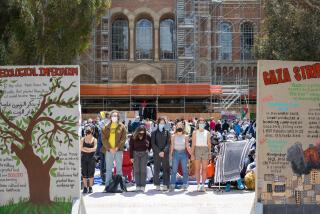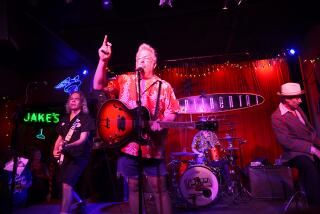RICHARD NIXON: 1913-1994 : THE NIXON CHRONOLOGY
- Share via
* Jan. 9, 1913--Born Yorba Linda; attended elementary schools in Yorba Linda and Fullerton.
* 1922--Moved to Whittier, where his father ran a general store and service station.
* 1926--Starts at Whittier High School; elected student body president; favorite subjects are history and civics.
* 1930--Starts Whittier College; is elected student body president and plays on the football team.
* 1934--Graduates second in class from Whittier College; starts at Duke University Law School.
* 1937--Graduates third in class of 44 from Duke University.
* 1939--Returns to Whittier; practices law in Whittier and La Habra.
* 1939--Named to Whittier College Board of Trustees; youngest trustee in college’s history at age 26.
* 1940--Marries Thelma Catherine (Pat) Ryan; they met while auditioning for play in Whittier.
* 1942--Joins Navy and serves during WWII as aviation officer on ground in Pacific.
* 1946--Elected to House of Representatives; runs tough campaign, accusing opponent, Rep. Jerry Voorhis, of being soft on communism.
* 1947--First term in Congress; gains fame in Alger Hiss case; becomes member of House Un-American Activities Committee.
* 1948--Reelected to House.
* 1950--Elected to the U.S. Senate; reputation grows as a ruthless campaigner unafraid to accuse opponent of being communist sympathizer in race against Rep. Helen Gahagan Douglas, a New Deal Democrat.
* 1952--Dwight D. Eisenhower takes Nixon as vice presidential running mate; Nixon is damaged by disclosure that California supporters were supplementing his Senate salary through $18,000 slush fund; he gives “Checkers” speech on national TV and wins back public approval; Eisenhower and Nixon win the election.
* 1953--Nixon becomes vice president; increasingly fills in for ailing Eisenhower.
* 1956--Eisenhower-Nixon ticket is reelected; in his second term, Nixon takes greater role in foreign policy.
* 1959--Nixon visits Moscow; has “kitchen debate” with Soviet leader Nikita Khrushchev.
* 1960--Nixon runs for President, takes part in first TV debates. John F. Kennedy narrowly wins in closest presidential contest in history.
* 1961--Returns to California; practices law in Los Angeles.
* 1962--Wins GOP nomination for governor of California; loses election to incumbent Edmund G. (Pat) Brown.
* 1963--Moves to New York to practice law; remains politically active by campaigning for GOP candidates.
* 1968--Wins GOP presidential nomination; defeats Vice President Hubert H. Humphrey to become the nation’s 37th President.
* 1969--Nixon takes office and begins withdrawing troops from South Vietnam; military draft lottery system begins; gives “Silent Majority” speech; antiballistic missile system proposed.
* 1970--Nixon decides United States will invade Cambodia, setting off protests nationwide; in domestic affairs, he sets up the Environmental Protection Agency.
* June 17, 1972--Political burglars later linked with the Committee for the Reelection of the President are arrested during a break-in at Washington’s Watergate complex.
* 1972--Nixon reelected in a landslide, defeating McGovern; becomes first U.S. President to visit China while in office.
* 1973--Senate investigations of the Watergate scandal begin; Nixon withdraws United States from Vietnam War.
* Oct. 10, 1973--Vice President Spiro T. Agnew resigns from office under investigation for graft.
* October, 1973--Impeachment hearings begin.
* Dec. 6, 1973--Nixon names Rep. Gerald R. Ford of Michigan as vice president.
* July, 1974--House Judiciary Committee recommends impeachment.
* August, 1974--Nixon resigns.
* September, 1974--Ford pardons Nixon.
* 1974--Nixon moves back to San Clemente; sues to keep control of his presidential papers.
* 1977--David Frost interviews Nixon in his first return to public view; Nixon said, in discussing Watergate, that it might be correct for a President to break the law if he did so in the national interest.
* 1978--Nixon publishes memoirs.
* 1980--He moves to New York City; writes foreign policy book.
* 1981--He moves to Saddle River, N.J.
* 1982-90--He writes four more foreign policy books; Nixon is embraced by GOP as an elder statesman.
* July, 1990--Richard Nixon Library & Birthplace opens in Yorba Linda.
* June 22, 1993--Pat Nixon, 81, dies of lung cancer and is buried four days later in a garden at the Nixon library.
* Jan. 20, 1994--Nixon visits library to unveil plans for a new $25-million Policy Research Center for Peace and Freedom to be built there.
* March 6, 1994--Nixon arrives in Moscow for his 10th and final visit and is snubbed by President Boris Yeltsin’s government for meetings he arranged with Yeltsin foes blamed for bloody power struggles last year that claimed almost 200 lives.
* April 22, 1994--Nixon pronounced dead at 9:08 p.m. EDT at New York Hospital-Cornell Medical Center, four days after suffering a massive stroke at his Park Ridge, N.J. home.
Nixon Burial
Richard Nixon’s casket will be on public view until 3 p.m. today. After a funeral service for invited guests, interment will take place in a family -only ceremony. Guests will hear the graveside portion over loudspeakers.
More to Read
Sign up for Essential California
The most important California stories and recommendations in your inbox every morning.
You may occasionally receive promotional content from the Los Angeles Times.













